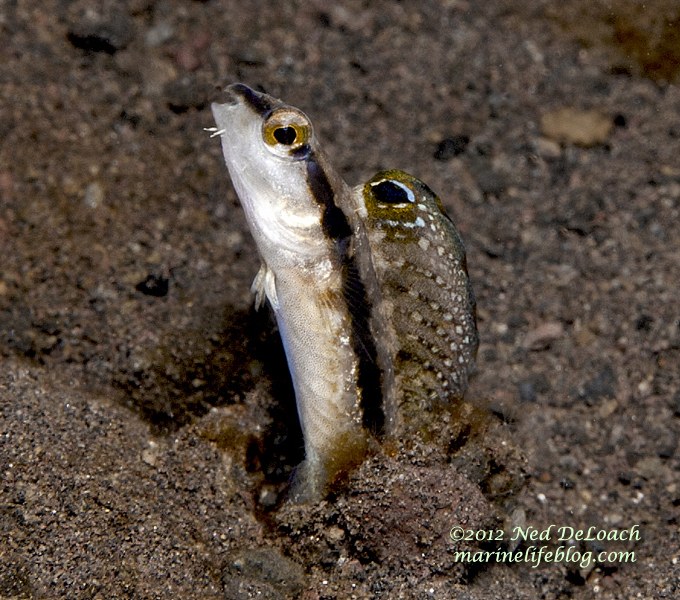Our friends Ned and Anna DeLoach (of New World Publications, Inc. and blennywatcher.com) are reef explorer superstars! In 2010, they discovered a new fairy wrasse, which was only officially described as Cirrhilabrus humanni earlier this year. Now Ned may have discovered a new flagblenny.
Ned tells his story at Marine Life Blog and shares it with us:
By coincidence, fangblennies happen to be fresh on my mind. Just the week before with the help of our ID book, Anna and I identified a similar-appearing species that turned out to be a Smith’s Fangblenny. But from what I briefly saw, my mystery fish seems different from the fangblennies I remember from the book. After ten minutes the tip of a tiny head with an under-slung mouth slowly emerges, followed by a set of goggle eyes. One look at me, and the fish disappears once again. This game of peek-a-boo continues for 30 minute before the front half of a white and black body bearing an impressive dorsal fin with an ocellated spot extends from the hole. I snap off a shot and inch forward spooking the fish back underground. By the time the divers troop back up the slope an hour later, the fish still hasn’t completely emerged, but I feel I have a sufficient image for an ID.
Back at the resort with the fish’s image glowing on my computer screen, I compare it with six pages of fangblennies in the book, but can’t make an ID. That evening I email the photo to ichthyologist Gerry Allen with Conservation International and co-author of our Pacific fish book. Stumped, Gerry forwards the photo to Bill Smith-Vaniz, a blenny specialist in Florida, who deems it to be a new, undescribed species.
After we leave for home Mark Erdmann, Gerry’s colleague at CI arrives at Scuba Seraya. With help from the guides and dive director Doris Hug, Mark relocates and captures the fish. As I am writing this, the fangblenny is on his way to Florida where Dr. Simth-Vaniz has consented to undertake the descriptive work. And most exciting, if it indeed turns out to be a new species, he has graciously agreed to name the fangblenny after Scuba Seraya in honor of our group’s memorable visit.
The ocean is a big and largely unexplored space. Even popular resort dive sites are ripe for discovery.
-

- The Fish Dentist
Read Kenneth Wingerter’s Advanced Aquarist article to learn more about Flagblennies. And we highly recommend you read Ned’s entire Bali story at Marine Life Blog. His terrific article is filled with interesting accounts and top-notch sea life photos like this photo of a cleaner shrimp servicing a Tomato Grouper.











0 Comments